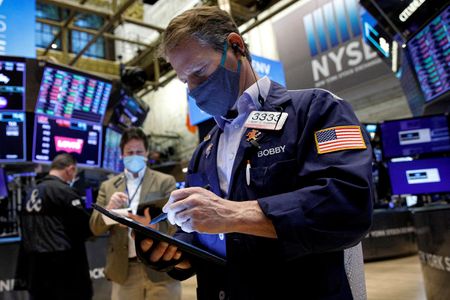

By Herbert Lash and Marc Jones
NEW YORK/LONDON (Reuters) – Benchmark U.S. Treasury yields jumped to two-year highs and major equity market indexes fell more than 1% on Tuesday as traders braced for the Federal Reserve to be more aggressive in tightening monetary policy to tackle inflation.
The dollar hit a six-day high following the jump in Treasury yields, while inflation fears were bolstered as oil prices rose to their highest since 2014 on possible supply disruptions after attacks in the Gulf increased a tight supply outlook.
The jump in Treasury yields slammed U.S. and European technology stocks, while a drop in Goldman Sachs’ stock led declines among U.S. banks after it missed quarterly earnings as the Fed slowed its asset purchases in November.
Two-year Treasury yields, which track short-term interest rate expectations, rose above 1% for the first time since February 2020 as traders priced in a more hawkish Fed before the U.S. central bank’s policy meeting next week.
The two-, three- and five-year part of the yield curve will bear the brunt of expected Fed policy, said Tom di Galoma, a managing director at Seaport Global Holdings in Greenwich, Connecticut.
“The front end of the market is still way underpriced for Fed tightenings. The two-year note could be 1.5% by March,” he said.
The two-year Treasury yield rose 7.3 basis points to 1.040% and the yield on the benchmark 10-year Treasury note advanced 9.3 basis points to 1.865%.
Yields have jumped since minutes viewed as hawkish from the Fed’s December policy meeting showed it may raise rates sooner than expected and begin reducing its asset holdings to slow inflation and address a “very tight” labor market.
The tech-centric megacap stocks led the decline on Wall Street and interest rate-sensitive financials was the biggest declining S&P 500 sector, down about 2.2%.
Tech stocks also weighed the most in Europe, falling 1.9%, as European shares fell to their lowest level in more than a week. The pan-European STOXX 600 index fell as much as 1.44% before paring some losses to close down 0.97%.
Securities will continue to revalue as the market anticipates rate hikes, said Michael O’Rourke, chief market strategist at JonesTrading in Stamford, Connecticut.
“We still have a bit of a ways to go to prepare for three rate hikes or four rate hikes. We haven’t priced that in,” he said.
On Wall Street, the Dow Jones Industrial Average slid 1.08%, the S&P 500 fell 1.28% and the Nasdaq Composite slipped 1.76%.
MSCI’s all-country world index fell 1.22% as tech stocks dropped in Asia overnight despite China easing policy again.
Investors are increasingly pricing in as many as four Fed rate hikes this year and even one from the European Central Bank.
Big market declines often occur in years following outsized gains on Wall Street. There have been nine sell-offs starting in the first quarter that averaged 10.9% since World War Two, said Sam Stovall, chief investment strategist at CFRA Research.
However, “history is a great guide, but it’s never gospel,” he said.
Oil was the only positive sector on Wall Street as Brent crude prices hit $88 a barrel after Yemen’s Houthi group attacked the United Arab Emirates, escalating hostilities between the Iran-aligned group and a Saudi Arabian-led coalition.
Brent crude futures rose $1.03 to settle at $87.51 a barrel. U.S. crude futures settled up $1.61 at $85.43 a barrel.
Gold prices fell. U.S. gold futures settled down 0.2%at $1,812.40 an ounce.
Japan’s yen fell after the Bank of Japan said it would stick to its ultra-loose monetary policy, despite hopes the economy is finally kicking clear of deflation.
Russia’s rouble, highly volatile recently, firmed 0.92% to 76.77 a dollar after reports the West was no longer considering cutting Russian banks off from the Swift global payments system and was instead eyeing sanctions on banks.
(Reporting by Herbert Lash, additional reporting by Sinéad Carew in New York and Marc Jones in London; Editing by Ed Osmond, Raissa Kasolowsky, Chizu Nomiyama and Jonathan Oatis)

